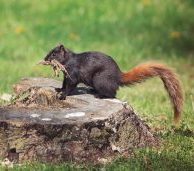Squirrels use some serious foot stomping – which usually translates as some kind of warning signal. But they also use plenty of other different methods of body language.
Why Do Squirrels Tap Their Feet?

Most rodents have evolved ways to communicate with the tools they have – and to their best advantage. Foot thumping is one of these things and most squirrels are either underground or on the ground – and vibrations from foot thumping can travel a long way. Further than shouting.
Squirrels as a rodent group use foot thumping less often than other rodents like gerbils and elephant shrews – but when they do it – you can’t miss it. They often use it to transmit warnings of some sort or to indicate a threat (either a predator or to others of the same species).
1) Defending Territory:
Many tree squirrels are solitary – but they do still come into contact with each other and often share great feeding grounds when in urban areas – but when food is scarce or they feel the need to stand their ground for something – they will often tap their feet. A non-verbal way of saying -‘back off – this is mine’ – and hopefully avoid the need for a fight. Animals have ways of avoiding getting hurt – and squirrels are no different.
2) Mating Communication:
Often, foot thumping is not only a signal that mating could be about to occur – or is being demanded – stamping can help a couple locate each other. Mating is a long affair in the treetops or underground depending on what type of squirrel you are, so they need to let each other know that they are still close by and that they are still interested.
3) Danger Warning:
Communicating that you have seen a predator is one of the ways that animals react – but why? Well, it’s been proposed by scientists that the squirrels are actually communicating with the predator. By making a specific noise when a snake approaches for example – they are letting all the other squirrels know to run off – but they are also ‘telling’ the snake that they are aware it is there and everyone is now safe and the snake usually leaves with an empty tummy. This works long term too – as if everywhere the snake gets spotted – the snake hears the same thumping and gets no food time after time. Needless to say – next time it hears the thumping it may just give up anyway?
How Do You Stop A Squirrel Stomping Their Feet?
You can’t. You just have to wait – patiently and non-threateningly. Basically, if you have startled a squirrel – and it starts foot tapping as a warning to them and you too – it will keep tapping until you leave or they feel safe.
The problem is that if you try to do things to help calm them down like moving to a different place or trying to talk to them or put food down – all these could restart the clock on the foot-tapping.
Do Squirrels Tap Their Feet as a Sign of Sleep Disturbance?
Many wonder about squirrel sleeping habits at night. One interesting behavior they exhibit is tapping their feet. However, it is not necessarily a sign of sleep disturbance. Rather, it could be a way for squirrels to alert others or communicate with their group.
How Else Do Squirrels Communicate?

These savvy rodents are very communicative in many ways. Apart from foot-stomping they also communicate with their tail, body, and voices.
Tail swishing is a great one if you are wondering whether the squirrel in front of you is friendly or not – the answer is no! A squirrel swishing its tail is like a dog growling or a horse flattening its ears. You do NOT want to get any closer to that squirrel. They also can sort of flap their tails upright from side to side to make themselves seem larger – usually seen when a squirrel is confronted by a snake.
Their whole body position is also a sign of what they are thinking. A tall erect stance clearly shows that they are ready for action – they are watching everything and can react at lightning speed. A low forward-crouching pose – especially when accompanied by tail swishing is a clear ‘ready to attack’ pose. Please leave immediately!
Vocalizations are another easy way to identify a squirrel and understand it. Barks, yaps, and screeches all tell a story – such as warnings, family chat, and alerts – and well as lower reassurance chatting between each other. Kits in the nest have a whole repertoire unique to that time when they are with their mother. There are also sounds specific to attracting and reacting to a mate.
They really are quite the social animals, these tree squirrels – even though they are generally a solitary species.










